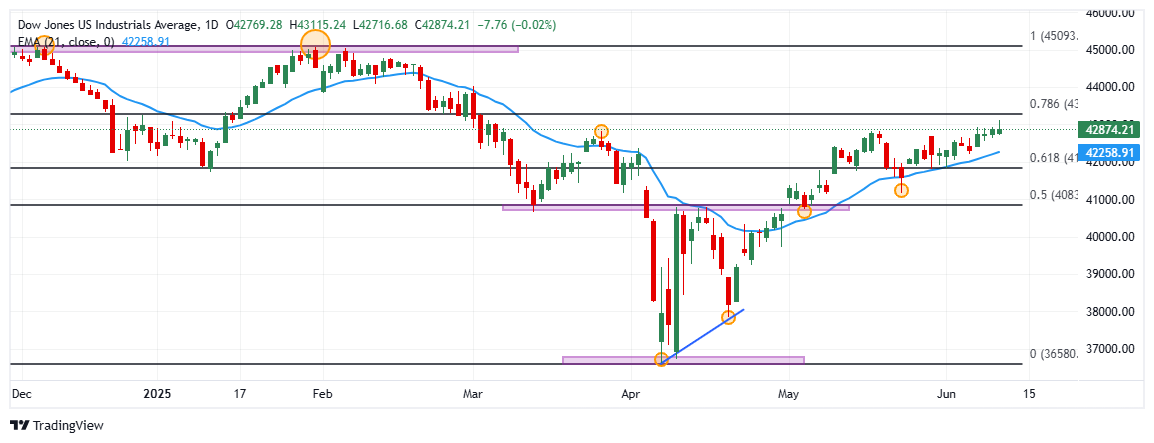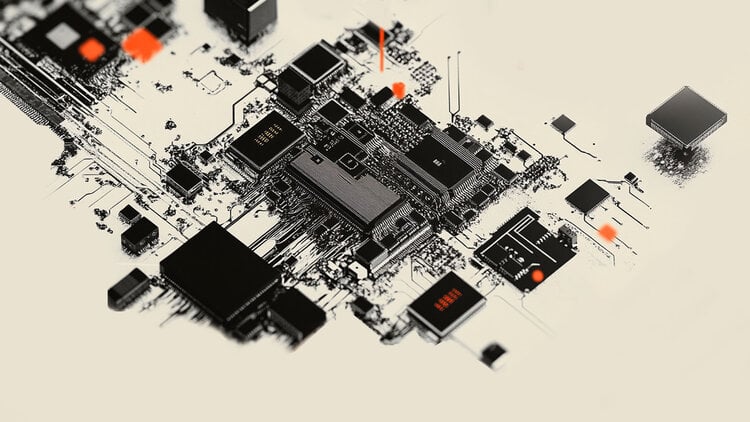- The Dow Jones goes back 0.02% daily, after reaching maximums of March 5 in 43,115.
- The Nasdaq 100 loses 0.35% in the day, dragged by Intel Corporation (INTC).
- The S&P 500 falls 0.27% today, currently operating over 6,021.
- The consumer price index rises 2.4% in May, below analysts’ estimates.
The Dow Jones reacted down from March 5 in 43,115, attracting aggressive vendors that took the index to a minimum of the day in 4,2716.
The Dow Jones industrial average began negotiations at 42,769, while the Nasdaq 100 technological index opened at 21,901. The S&P 500 began operating in 6,023, ending the day within the operating range of June 10 in 6,021.
The Dow Jones quote down the Amazon and Home Depot
The Dow Jones index slides 0.02% on Wednesday, operating currently at 42,874.
The Amazon (AMZN) values lose 2.03% in the day, today reaching minimum of June 9, ending with a streak of five consecutive days on the rise.
Following the upward perspective, the HOME DEPOT (HD) shares decrease 2.02% daily, reaching minimum not seen since May 7 in 359.31 $.
The Dow Jones falls 7 points today after reaching maximums of more than three months in 43,115.
Intel and Atlassian Corporation lead the losses in Nasdaq 100
The Nasdaq 100 technological index falls 0.35% on the third day of the week, reacting down from the maximum of February 24 at 22,064.
Intel Corporation Titles (INTC) collapse 6.34% today, staying within the operational range of the previous session at $ 20.68, cutting a streak of three consecutive sessions upwards.
In the same tune, the actions of Atlassian Corporation (Team) decoced 5.42% daily, visiting minimums of June 2 in 200.92 $, spinning 2 consecutive days with losses.
The Nasdaq 100 slides 76 points, operating when writing about 21,861.
The S&P 500 reaches maximums of more than three months after the moderation of the United States CPI
According to information provided by the US Labor Statistics Office, the consumer price index increased by 2.4% year -on -year in May, below the estimated 2.5% and exceeding 2.3% observed in April.
Nucor Corporation Shares (Nue) lose 6.06% in the day, reaching minimum of June 3 at $ 116.21.
In this context, the S&P 500 falls 0.27% daily, losing 16 points, consolidating within the operating range of June 10 in 6,021.
Technical Analysis of Dow Jones
The Dow Jones formed a short -term support given by the minimum of May 23 in 41,175. The following important support is observed in 40,747, minimum of May 6 in convergence with the 50% fibonacci setback. Upwards, the key resistance is 45,068, a pivot point of January 31, 2025.
Dow Jones daily graphics

Dow Jones Faqs
The Dow Jones Industrial Avenge, one of the oldest stock market indexes in the world, consists of the 30 most negotiated values in the United States. The index is weighted by the price instead of capitalization. It is calculated by adding the prices of the values that compose it and dividing them by a factor, currently 0.152. The index was founded by Charles Dow, also founder of the Wall Street Journal. In recent years it has been criticized for not being sufficiently representative, since it only follows 30 companies, unlike broader rates such as S&P 500.
There are many factors that promote the Dow Jones Industrial Average (DJIA) index. The main one is the added performance of the companies that compose it, revealed in the quarterly reports of business benefits. The American and world macroeconomic data also contribute, since they influence investor confidence. The level of interest rates, set by the Federal Reserve (FED), also influences the DJia, since it affects the cost of credit, on which many companies depend largely. Therefore, inflation can be a determining factor, as well as other parameters that influence the decisions of the Federal Reserve.
Dow’s theory is a method to identify the main trend of the stock market developed by Charles Dow. A key step is to compare the direction of the Dow Jones Industrial Avenge (DJIA) and the Dow Jones Transportation Average (DJTA) and just follow the trends in which both move in the same direction. The volume is a confirmation criterion. The theory uses elements of maximum and minimum analysis. Dow’s theory raises three phases of the trend: accumulation, when intelligent money begins to buy or sell; Public participation, when the general public joins the trend; and distribution, when intelligent money abandons the trend.
There are several ways to operate with the DJ. One of them is to use ETF that allow investors to negotiate the DJ as a single value, instead of having to buy shares of the 30 companies that compose it. An outstanding example is the SPDR Dow Jones Industrial Avenge ETF (day). Future contracts on the DJ allow the specular operators about the future value of the index and the options provide the right, but not the obligation, to buy or sell the index at a predetermined price in the future. Investment funds allow investors to buy a part of a diversified portfolio of DJ values, which provides exposure to global index.
Source: Fx Street
I am Joshua Winder, a senior-level journalist and editor at World Stock Market. I specialize in covering news related to the stock market and economic trends. With more than 8 years of experience in this field, I have become an expert in financial reporting.





